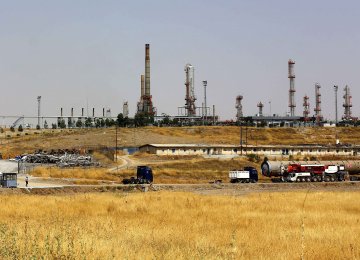Output from Yadavaran joint hydrocarbon deposit with Iraq located 70 kilometers west of the city of Ahvaz in Khuzestan Province near the Iraqi border has exceeded 100 million barrels since the field's first phase went on stream in November 2016, the head of the field's development plan in the Petroleum Engineering and Development Company said.
"Although the venture was aimed at producing 85,000 barrels per day, Iran's daily extraction from the joint field amounts to 112,000 barrels," Hadi Nazarpour was quoted as saying by Shana on Sunday.
Pointing to the reserve's recovery rate for light and heavy crude oil, which stands at 15% and 7% respectively, Nazarpour saidd, "Based on recent studies, the field's in-place crude reserves were revised to more than 34 billion barrels from 12 billion barrels that is why taking steps to tender the second development phase of Yadavaran Oilfield in an oil block known as the West Karoun in Khuzestan Province is at the top of the National Iranian Oil Company's agenda."
According to the official, documents are being prepared and a tender will be held soon.
"The extraction rate can reach 135,000 bpd in the first phase," he said, adding that talks are being held between the NIOC and multinationals, namely French energy giant Total S.A., Royal Dutch Shell Plc, Italy's Eni SpA, Japan's Inpex Corp and China Petroleum & Chemical Corporation (Sinopec), to participate in the tender to develop the second phase of the field based on Iran Petroleum Contract, a new model of contracts that will be used to develop upstream exploration/production projects.
He noted that the field's output is expected to reach 180,000 barrels per day in the second phase before exceeding 300,000 bpd in the third. Around 83,000 barrels of Yadavaran production are a blend of light crude and the rest is heavy crude. Asked about the western Arab neighbor, he said Iraq started production from Yadavaran last year. Several joint fields, including Azadegan, Yadavaran, Yaran, Azar, Dehloran, West Payedar and Naft Shahr are shared between Iran and Iraq.
But the war-ravaged Arab neighbor has fared far better in production from the shared fields as it has successfully opened up its oil and gas sector to international companies such as Shell, BP, Eni, ExxonMobil, Total and Gazprom. According to reports, Iraq's crude oil production has almost doubled to 4.7 million barrels per day this year from 2.4 million bpd at the start of the decade, overtaking sanctions-hit Iran as the second biggest producer of the Organization of Petroleum Exporting Countries.
Iraq's inroads came as Iran was slapped by tougher international sanctions in 2011 and 2012, which ostensibly targeted its nuclear program but significantly undermined its economy and the key oil sector. According to a Majlis Research Center report in 2013, Iran produced around 130,000 barrels of oil from joint fields with Iraq while the western Arab state produced 295,000 barrels.
Lack of access to modern technology and budget has hampered the development of joint fields, allowing neighbors to draw the lion's share of underground reserves.
According to Oil Minister Bijan Namdar Zanganeh, Iran needs $50 billion to develop the joint oil and gas fields.











Add new comment
Read our comment policy before posting your viewpoints